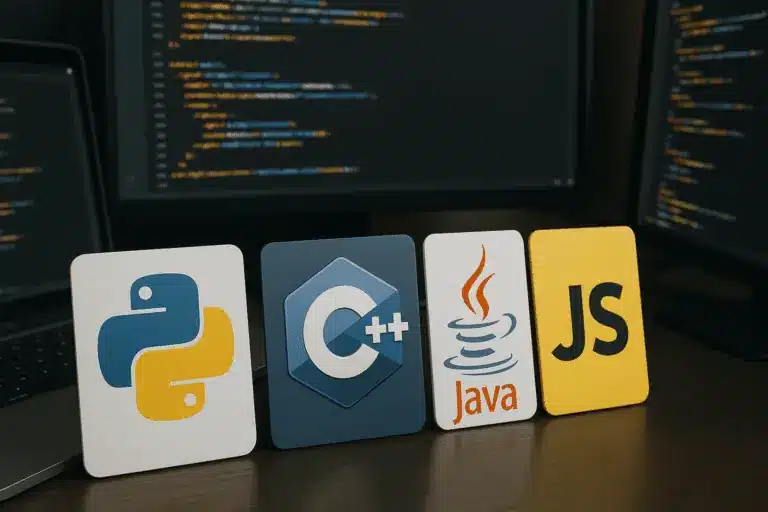Computer languages are crucial for the development of software, applications, and modern technology. They act as interfaces between humans and machines, enabling effective and structured communication with computers. In this article, we will explore computer languages in depth, from their definition to their evolution, covering types of languages, programming paradigms, and technical aspects such as compilers and interpreters. Whether you’re a beginner or looking to deepen your understanding, this exploration will offer a comprehensive insight into the topic.
What is a computer language?
A computer language is a system of communication between humans and computers, specifically designed to instruct the machine. These languages can either be interpreted or compiled, and they are essential for developing programs that carry out specific tasks such as running applications, processing data, or managing user interfaces.
Computer languages enable the formulation of algorithms which are then executed by the computer. Each language contains its own syntax (structural rules) and semantics (instruction meanings), which must be adhered to for the program to function correctly.
Why are computer languages important?
Computer languages are fundamental to all modern applications and have a wide range of applications across various fields such as:
- Software development: Every program or application we use daily is based on a computer language.
- Process automation: Scripts can be created to automate repetitive tasks, enhancing system efficiency.
- Artificial intelligence and data science: Languages like Python and R are employed for data processing and training machine learning models.
Communication with computer hardware: Languages allow programmers to write instructions that computers, servers, and other equipment can understand and execute.

What are the types of computer languages?
Computer languages can be categorized into three primary groups: low-level languages, high-level languages, and scripting languages.
Low-level languages
Low-level languages are close to machine language, which is the binary code directly understood by the computer. Although more challenging for humans to write and comprehend, they allow maximum performance optimization of the program.
Example: Assembly is a low-level language that directly translates into machine instructions.
High-level languages
High-level languages are abstract and more similar to human languages. They are easier to understand and manipulate while being powerful enough for developing complex applications.
Examples: Python, used in data science, artificial intelligence, and web development, Java is chosen for enterprise applications and mobile development (Android), and C++ is used for systems demanding optimal performance, such as video games or system software.
Scripting languages
Scripting languages are mainly employed to automate simple tasks or execute instructions sequentially. They are often interpreted, meaning the code is executed directly without prior compilation.
Examples: JavaScript is the dominant language for interactive web development, while PHP is primarily used in server-side web development.

What are programming paradigms?
Computer languages are often organized around programming paradigms, which define how programs are structured and tasks are carried out. The main paradigms include:
Programming Paradigm | Description | Examples of Languages | Typical Applications |
Imperative Programming | Executes a sequence of commands that alter the program state. The how is explicit. | C, Python | Simple computational tasks, precise memory management, automation scripts |
Object-Oriented Programming | Organizes code into objects and classes that represent entities. Promotes modularity and reusability. | Java, C++, Python | Complex software, mobile applications, enterprise management systems |
Functional Programming | Utilizes pure functions and avoids side effects. Promotes immutability and parallelism. | Haskell, Scala | Banking systems, large-scale data processing, critical environments |
Compilers and interpreters: How code is executed
Computer languages can be executed in various ways, primarily through compilers or interpreters. These tools are essential in converting programs into instructions comprehensible to machines.
1. Compiler
A compiler translates source code into executable machine language in a single pass before you run the program. This results in faster program execution since the code is already converted into binary. Examples of compiled languages: C, C++. The advantages include fast program execution and advanced optimization, yet it involves longer compilation times, complicating quick change testing.
2. Interpreter
An interpreter executes the source code line by line without generating binary code beforehand. It provides flexibility, allowing for immediate code testing, but may result in slower execution. Examples of interpreted languages: Python, JavaScript. These can be quickly tested and interacted with, although they typically possess slower execution compared to compiled languages.

Programming Language Comparison
Language | Type | Main Paradigm | Main Applications | Ease of Learning | Use Cases |
Python | High-level | Imperative, functional | Web development, AI, data science | Very easy | Web applications, data analysis scripts |
C++ | High-level | Imperative, Object-Oriented | Game development, embedded systems | Medium | Video games, operating systems |
JavaScript | Scripting | Imperative, Object-Oriented | Interactive web development | Easy to medium | Interactive websites, web applications |
Java | High-level | Object-Oriented | Mobile apps, enterprise | Medium | Android, enterprise systems |
Haskell | High-level | Functional | Parallel and distributed systems | Difficult | Scientific computing, reliable systems |
PHP | Scripting | Imperative | Server-side web development | Medium | Dynamic websites, e-commerce |

The evolution of computer languages: Adapting to new technologies
Computer languages have evolved to meet the expanding demands of modern technology. Languages popular in the 90s, such as C or Java, remain dominant in certain industries, but new languages are emerging to address specific challenges:
- Languages for Artificial Intelligence (AI): Python is the leading choice for AI projects due to its simplicity and extensive libraries like TensorFlow and PyTorch.
- Languages for web development: JavaScript and its associated frameworks, like React or Vue.js, are at the forefront of modern user interface development.
- Languages for parallel computing: Haskell and Scala are preferred for their capability to manage parallel and distributed operations.
Conclusion
Computer languages form the backbone of all software development. Whether you are new to programming or have experience, understanding the various language categories, their paradigms, and their evolution is crucial for progress in the computing field. Selecting a language should be guided by your objectives, projects, and the specific tools you intend to use. With a solid foundation in programming languages, you’ll be well-prepared to tackle tomorrow’s technological challenges.










